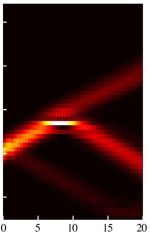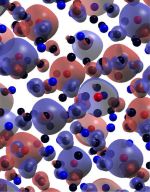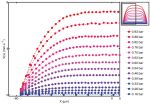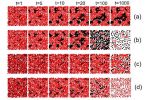News
EPJ B Highlight - Coupled particles cross energy wall
- Details
- Published on 05 June 2013

Model demonstrates that it is possible for two particles to cross an energy barrier together, where a single particle could not
For the first time, a new kind of so-called Klein tunnelling—representing the quantum equivalent of crossing an energy wall— has been presented in a model of two interacting particles. This work by Stefano Longhi and Giuseppe Della Valle from the Institute of Photonics and Nanotechnology in Milan, Italy, has just been published in EPJ B.
Klein tunnelling is a quantum phenomenon referring to the fact that a high-potential barrier can be transparent to a particle moving at a speed nearing that of light, referred to as relativistic. Most of the previous Klein tunnelling models describe the phenomenon for a single particle. However, when two particles are involved, tunnelling can be modified as a result of their mutual interaction. This means, for example, that two electrons hopping on a lattice, or two ultra-cold atoms trapped in an optical lattice can exchange energy when they occupy the same lattice site.
EPJ B Highlight - Promising doped zirconia
- Details
- Published on 17 May 2013

A new study discusses the electric and magnetic characteristics of a material which could be used in spintronics
Materials belonging to the family of dilute magnetic oxides (DMOs) — an oxide-based variant of the dilute magnetic semiconductors — are good candidates for spintronics applications. This is the object of study for Davide Sangalli of the Microelectronics and Microsystems Institute (IMM) at the National Research Council (CNR), in Agrate Brianza, Italy, and colleagues. They recently explored the effect of iron (Fe) doping on thin films of a material called zirconia (ZrO2 oxide). For the first time, the authors bridged the gap between the theoretical predictions and the experimental measurements of this material, in a paper just published in EPJ B.
EPJ D Highlight - Elucidating energy shifts in optical tweezers
- Details
- Published on 15 May 2013

Physicists are providing an all-in-one guide to help calculate the effect the use of optical tweezers has on the energy levels of atoms under study
A small piece of paper sticks to an electrically charged plastic ruler. The principle of this simple classroom physics experiment is applied at the microscopic scale by so-called optical tweezers to get the likes of polystyrene micro-beads and even living cells to “stick” to a laser beam, or to trap atoms at ultra-low temperatures. Physicist Fam Le Kien and his colleagues from the Institute of Atomic and Subatomic Physics of the Vienna University of Technology, Austria, provide a comprehensive manual with general theoretical tools, definitions, and spectroscopic data sets for calculating the energy levels of atoms, which are modified by light emanating from optical tweezers, in a study just published in EPJ D.
EPJ Nonlinear Biomedical Physics: A new Open Access journal is launched
- Details
- Published on 15 May 2013

The publishers of EPJ are pleased to announce the launch of a new Open Access journal: EPJ Nonlinear Biomedical Physics. A Commentary and two Research papers are already available.
This new peer-reviewed journal will promote and disseminate new research in the field of quantitative biomedical complexity science. Its special focus is on the applications of nonlinear dynamics and complexity-inspired integrative systems science, to the quantitative modeling and understanding of how structure, function and/or dysfunctions and diseases emerge in complex biomedical matter, systems and processes.
EPJ E Highlight - Microgels’ behaviour under scrutiny
- Details
- Published on 01 May 2013

A new study explores the counter-intuitive behaviour of a microgel composed of soft polymer blobs
Being a physicist offers many perks. For one, it allows an understanding of the substances ubiquitous in everyday industrial products such as emulsions, gels, granular pastes or foams. These are known for their intermediate behaviour between fluid and solid. Paint, for example, can be picked up on a paintbrush without flowing and spread under the stress of the brush stroke like a fluid. Baudouin Geraud and colleagues from the Light Matter Institute at the University of Lyon, France, have studied the flow of a microgel confined in microchannels. They have shown, in a study just published in EPJ E, that its behaviour under confinement differs from predictions based on standard theories. Indeed, its molecules are not only subjected to local forces, but also to neighbouring forces that affect its flow.
EPJ Plus news: Eugenio Nappi joins Luisa Cifarelli as EiC of EPJ Plus
- Details
- Published on 01 May 2013

EPJ Plus welcomes Eugenio Nappi as co-Editor in Chief, alongside Luisa Cifarelli. Nappi is Director of Research at INFN, the Italian Istituto Nazionale di Fisica Nucleare. He is an experimental particle physicist who has carried out most of his research activities at CERN and DESY.
His main research interests include the study of heavy nucleus collisions at ultrarelativistic energies with the ALICE Experiment at LHC, where he held the highest managerial positions. In 2000, he became project leader of the Cherenkov system, named HMPID, the largest CsI Ring Imaging Cherenkov (RICH) detector ever built. In the same year he joined the HERMES experiment at HERA-DESY. In HERMES, he spearheaded the design of the first-ever aerogel radiator RICH detector. More recently, he has become interested in medical imaging and joined the AXPET collaboration at CERN, which is intended to develop a new concept for Positron Emission Tomography (PET).
Author of more than 250 peer-reviewed papers, he is a member of the Executive Board of INFN, the ICFA Panel on Instrumentation, the CST of CNRS-IPN Orsay, the ECE (Expert Committee for the Experiments) of FAIR and the STC (Steering Committee) OF ESS (European Spallation Source).
EPJ H now has a second Managing Editor
- Details
- Published on 23 April 2013

Earlier this year Francesco Guerra, who had been a member of the editorial board of EPJ H - Historical Perspectives on Contemporary Physics since its launch in 2010, joined Wolf Beiglböck in managing the journal.
Prof. Francesco Guerra, a graduate from the University of Naples, is full professor of theoretical physics at the University of Rome 'La Sapienza'. He has served on many national academic evaluation committees and is currently a member of the Physics Panel of the National Agency for the Evaluation of Universities and Research.
His scientific interests include quantum field theory and elementary particles, stochastic methods in quantum mechanics, stochastic variational principles, statistical mechanics of spin glasses and complex systems, and the history of modern physics (in particular nuclear physics). In 2008, he was the recipient of the Italian Physical Society’s Prize for History of Physics.
EPJ E Call for papers: Thermal non-equilibrium phenomena in multi-component fluids
- Details
- Published on 17 April 2013

EPJE is inviting submission for a new topical issue on “Thermal non-equilibrium phenomena in multi-component fluids”. Under thermal non-equilibrium conditions, multi-component fluids generally undergo component separation. This is termed thermodiffusion in molecular liquids, and thermophoresis in colloidal fluids. The precise physical principles underlying these phenomena are still not understood, and it is envisaged that a continuous flow of ideas between theoreticians, experimental scientists and researchers employing numerical methods is needed to achieve a deeper understanding. In order to provide an overview of the more recent advances in this intriguing area, Fabrizio Croccolo and Henri Bataller will guest edit this topical issue on physical systems outside thermal equilibrium. The deadline for submission is 30 June 2014. Read the full call for papers to learn more about the scope and submission details.
EPJ B Highlight - Physicists decipher social cohesion issues
- Details
- Published on 10 April 2013

Studying the effect of migration on cooperation could help to better understand social cohesion
Migrations happen for a reason, not randomly. A new study, based on computer simulation, attempts to explain the effect of so-called directional migration – migration for a reason – on cooperative behaviours and social cohesion. These results appear in a study just published in EPJ B by Hongyan Cheng from Beijing University of Posts and Telecommunications and colleagues.
EPJ B Colloquium - Why heavy doping makes ultrafast plasmonic semiconductors
- Details
- Published on 02 April 2013
This EPJB Colloquium reviews the pioneering studies of plasmon resonance in heavily doped semiconductor thin films. It also reports the chemical synthesis and structural properties of heavily doped semiconductor nanocrystals. Their linear plasmonic response (under excitation with weak continuous-wave optical fields) is illustrated both theoretically and experimentally. Finally, the authors review the most recent results on the transient (i.e. nonlinear) ultrafast plasmonic features exhibited by chalcogenide nanocrystals under excitation with ultra-fast optical pulses, including a “gold-like” theoretical model. This model turns out to provide sufficient insights into the first experiments on heavily-doped plasmonic nanoparticles.
Plasmonics in heavily-doped semiconductor nanocrystals. Francesco Scotognella et al., Eur. Phys. J. B (2013) 86: 154, DOI: 10.1140/epjb/e2013-40039-x





